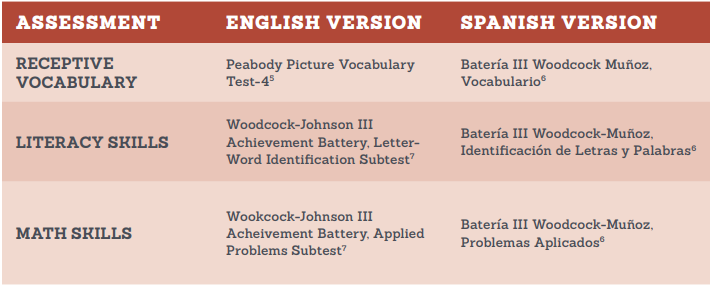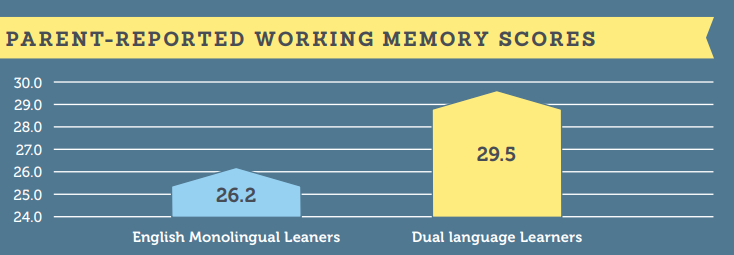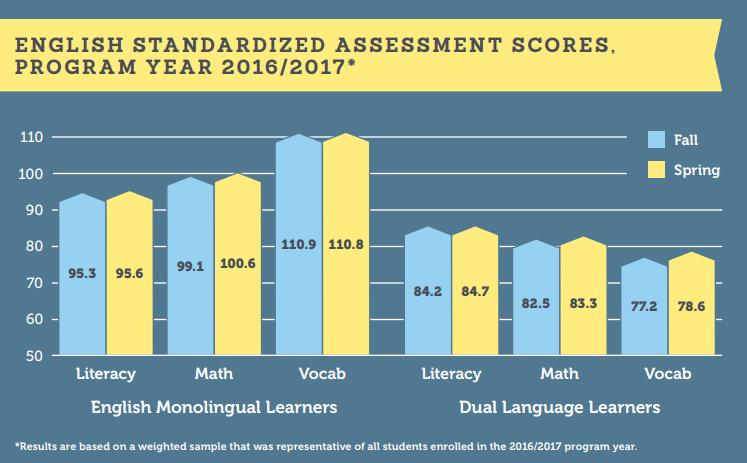2016–2017: CHILD OUTCOMES BRIEF
The vast majority of DPP Students are prepared for Kindergarten
ENSURING ACCESS TO
HIGH QUALITY PRESCHOOL
The Denver Preschool Program (DPP) champions universal access to high quality preschool for every Denver family with a 4-year-old regardless of income or neighborhood. Approved by Denver voters in 2006 and reauthorized in 2014 to extend to 2026, DPP is funded by a .15 percent sales tax. Approximately 70 percent of DPP’s funds are given back to Denver families in the form of tuition support for their child’s preschool. Through the end of the 2016-2017 school year, DPP distributed more than $106 million to nearly 50,000 students.
Providing Denver’s families with the opportunity to access high quality preschool is just the beginning of DPP’s vision to ensure that every child in Denver enters kindergarten ready to reach their full potential. In addition to tuition credits, DPP collaborates with over 250 preschools, 80 percent of which are highly rated1 , to guarantee that families have more choices for high quality preschools. Together, access to high quality preschool and supporting preschools in achieving and maintaining high quality programs increases the odds that Denver’s preschoolers will show up ready to thrive on the first day of kindergarten.
Previous research2 finds that DPP students show accelerated growth in vocabulary, literacy, and math during their preschool year. For the eighth consecutive year3, the vast majority of DPP students in the 2016-2017 Child Outcomes research study reached benchmarks that indicated they are ready for kindergarten.
SETTING
THE MARK
There is no single assessment that measures kindergarten readiness, but robust evidence suggests that having a strong foundation in the areas of vocabulary, literacy, and math play an important part in later academic success4. These three pre-academic skills are often captured through one-on-one direct assessments with students. With close to 5,000 students who receive DPP tuition credits yearly, it is nearly impossible to do direct assessments with every child. DPP partners with a team of researchers at Clayton Early Learning every year to get a representative sample of DPP students to estimate overall child outcomes.
In 2016-2017, 241 preschool students participated in the Child Outcomes Study. The students were directly assessed in the pre-academic domains in both the fall and spring semesters of their preschool year. The research team, responding to the linguistic diversity in Denver, gave Spanish-English dual language learners the opportunity to take the direct assessments in both English and Spanish.
PRE-ACADEMIC DIRECT CHILD ASSESSMENTS

READY FOR
KINDERGARTEN

MORE THAN
PRE-ACADEMIC SKILLS
The skills that make a child ready for kindergarten are not only academic in nature such as math, literacy, and vocabulary, but include other aspects like social-emotional, thinking and memory skills. In preschool, children are learning how to relate to their peers, manage their expanding and complex emotions, and follow directions. In addition to the direct assessments, teachers filled out information about the student’s social-emotional development12 and thinking and memory skills13.
In the spring before kindergarten, over 90 percent of DPP students in the study had scores that strongly indicated they were on target for social-emotional development skills, which include self-regulation, initiative and attachment. This means that students were displaying behaviors that teachers believe will allow the child to thrive inter-personally in environments like a kindergarten classroom.
Remembering instructions and thinking before acting are two skills that are useful in kindergarten and beyond. Teachers rated 75 percent of students as having relatively high skills in working memory (e.g., remembering instructions and multi-step directions). Nearly 81 percent of students were relatively high in inhibition skills (e.g., thinking first, then acting; and stopping an activity when asked). The high percentage of children who display these skills mean that the majority of children were well on their way to having the thinking and memory skills necessary to be aware, present, and ready to learn in kindergarten.


OUTCOMES OF
DUAL LANGUAGE LEARNERS
Nearly 44 percent of DPP families report speaking a language other than English at home, and most often indicate the other languages include Spanish (32 percent). In 2016-2017, dual language families received the highest amount of DPP tuition supports and were more likely to express that they benefited from DPP preschools14. Given the significant proportion of families utilizing DPP, we focused on outcomes of dual language learners.
In 2016-2017, on English assessments, dual language learners, of any two languages, had scores that slightly increased from fall to spring but lagged behind English monolingual students’ scores. Dual language learners’ scores not only trailed behind English monolingual scores; their average scores were also below lagging kindergarten readiness expectation scores of 85 points.
When researchers combine assessments and take the best score in either language for dual language learners, on average students do well in at least one language and reach kindergarten readiness expectations.
Responding to the large proportion of DPP students who report Spanish as the second language spoken at home, the researchers conducted direct assessments in both English and Spanish languages.
On Spanish assessments, Spanish-English dual language learners made significant gains in Spanish literacy and smaller gains in Spanish vocabulary across the year. In the spring of 2017, the average Spanish vocabulary and literacy scores met kindergarten readiness expectations.
Though limited, there is evidence that suggests that while dual language learners show deficits in English language acquisition they outperform English monolingual children in thinking tasks, such as divergent thinking, perspective taking, and symbolic representation15. Interestingly, in the 2016-2017 DPP Child Outcomes Study, dual language learners had higher average scores on working memory skills than monolingual English students as reported by parents. Given that, there many other ways to assess thinking and memory skills, these results show that dual language learners may be excelling in other kindergarten readiness domains not captured by the current research assessments.
Overall, these mixed results are not surprising, and are encouraging. Though, on average dual language learners lag behind monolingual English speakers, the fact that dual language learners are making gains across the year in both languages is promising and suggests that DPP providers are supporting language development for dual language learners.


Denver Preschool Program students in the 2016–2017 Child Outcomes Study were ready for kindergarten in pre-academic, social-emotional development, and thinking and memory domains. Further, dual language learners are making progress across the DPP school year in both English and Spanish languages.

Supporting Documentation
- Colorado Shines (2015). Colorado Shines program guide. Denver, CO. http:// www.coloradoshines.com/resource/1440607605000/asset_pdfs1/asset_pdfs1/ ColoradoShinesProgramGuide.pdf National Association for the Education of Young Children (2009). Where we stand on school readiness. Washington, DC. https://www.naeyc.org/sites/default/files/globally-shared/downloads/PDFs/ resources/position-statements/Readiness.pdf
- Green, S., & Mangles, D., & Reale, M. (2017). Denver Preschool Program Child Outcomes Evaluation 2015-2016: Part A: Preschool Progress and School Readiness, Evaluation Cohort 8 Preschool Report. Denver CO.
- Denver Preschool Program Child Outcome Reports, 2009-2017. https://dpp.org/ research-and-results/our-results
- Child Trends (2015). Indicators of child and youth well-being. Bethesda, MD. https://www.childtrends.org/wp-content/uploads/2015/07/07_School_Readiness. pdf
- Dunn, L. M., & Dunn, D. M. (2007). PPVT-4: Peabody picture vocabulary test. London, UK: Pearson Assessments.
- Muñoz-Sandoval, A. F., Woodcock, R. W., McGrew, K. S., & Mather, N. (2005). Batería III Woodcock-Muñoz: Pruebas de aprovechamiento. Itasca, IL: Riverside Publishing.
- Schrank, F. A., McGrew, K. S., Mather, N., Wendling, B. J., & LaForte, E. M. (2014). Woodcock-Johnson IV tests of achievement: Form A. Itasca, IL: Riverside Publishing.
- LeBuffe, P.A. & Naglieri, J.A. (2012). Devereux early childhood assessment for preschoolers, second edition. Lewisville, NC: Kaplan Early Learning Company
- Thorell, L. B., & Nyberg, L. (2008). The childhood executive functioning inventory (CHEXI): A new rating instrument for parents and teachers. Developmental Neuropsychology, 33(4), 536-552.
- The Butler Institute for Families, Graduate School of Social Work, University of Denver (2018). Denver Preschool Program Operations Evaluation: 2016-2017 Program Year. Denver, Co.
- Bank Street College. https://eclkc.ohs.acf.hhs.gov/hslc/tta-system/culturallinguistic/docs/benefits-of-being-bilingual.pdf
